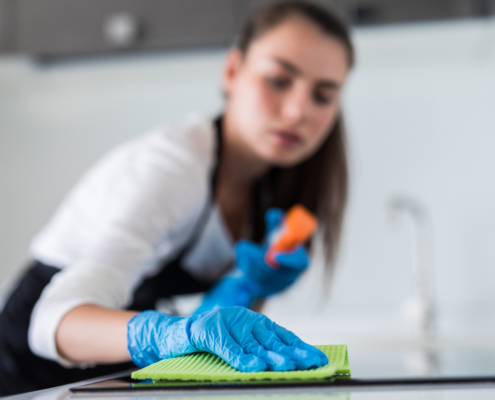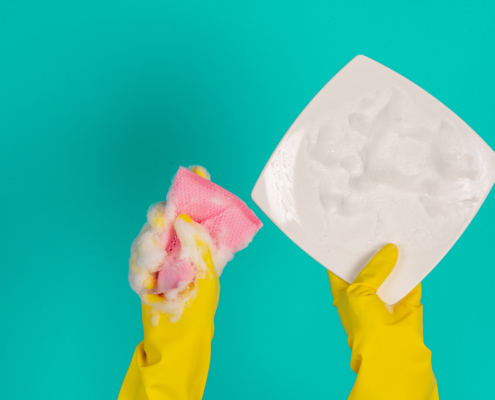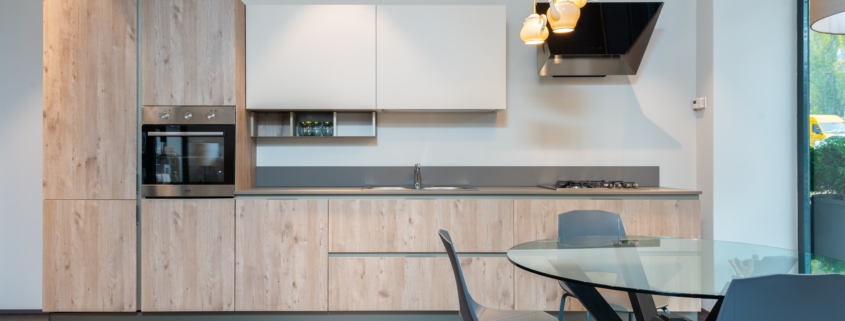Tips for Cleaning & Maintaining Your Kitchen Cabinets
Cabinets are an integral part of every kitchen, used for storing food, dishes, plates, utensils, and more. They can take up a lot of space and serve as one of the main focal points of the room. So, if dirty marks and unsightly stains start to appear on your kitchen cabinets, the whole space can start to look far less attractive. This is why it helps to know how to clean kitchen cabinets correctly.
Fortunately, cleaning kitchen cabinets is simple, once you know how, but you need to take the correct approach for each situation. Cleaning grease marks from wooden kitchen cabinets usually requires a different method to getting rid of stains and spots from your cabinets, for example. This guide will go over how to clean kitchen cabinets in various ways, with tips, tricks, and techniques you can rely on.
How Often Should I Clean Kitchen Cabinets?
Before we look at the finer points of the best way to clean kitchen cabinets, you might be wondering about how often you need to clean them in the first place. Well, if you want the best results, we recommend a weekly light clean of your cabinets; each week, you should use a simple cleaning solution and cloth to wipe away surface marks, like fingerprint marks and sauce or oil splatters.
It’s also a good idea to do a deeper, more intensive cleaning of your kitchen cabinets on a seasonal basis, up to four times a year. For this kind of clean, you’ll need to set aside more time. You should empty the cabinets of all their contents and clean all the interior walls and shelves, as well as the interior and exterior of the door. Make sure to let everything dry before filling the cabinets back up.

How to Clean Wood Kitchen Cabinets?
If you have wooden cabinets, you need to treat them with care and techniques for wooden cabinets. Different types of wood and finishes can react differently to certain cleaning methods and products, so it’s best to start off with gentle cleaners to avoid causing any unwanted damage. Follow these tips for best results:
- Use a gentle oil-based soap to clean your cabinets and leave them with a beautiful, natural shine.
- Use damp cloths, but don’t soak them with too much water, as excess moisture can damage the wood.
- After cleaning, buff your wooden cabinet doors and surfaces with a dry cloth. Remember to wipe in the direction of the wood grain when buffing or polishing.
- Pay close attention to cabinets in high-risk areas, like those above the stove that are regularly exposed to oil and steam.
How to Remove Grease from Cabinets?
When it comes to how to clean sticky wood kitchen cabinets with grease stains and marks, the key is persistence. You may need to wipe them over a few times to really get rid of those greasy marks, but if you keep at it, you should succeed. For a simple and affordable solution, dilute some vinegar with water and use this as your cleaning solution.
How to Remove Stains from Cabinets?
You might be wondering about how to clean white kitchen cabinets with big stains or unsightly marks on them. Stains are never pleasant, and it’s always best to try and prevent them from appearing in the first place by wiping away any splatters or surface marks as soon as you notice them. But what do you do if the stain has already been set and you can see colorful marks or water stains on your kitchen cabinets?
Well, for food stains, it’s best to try and use a damp cloth to wipe away as much of the stain as possible. Then, mix up some baking soda with water to form a paste and let it sit on the stain for five minutes, before wiping away. This should help to get rid of most household stains on your kitchen cabinets without too much effort required.
If you notice water stains on your cabinets, it’s a good idea to start using distilled water to clean them in the future, as your regular tap water could be too high in mineral content. And for other stains, like scuff marks, you may actually be able to use a regular school eraser to get rid of them. This works amazingly well on white cabinets, in particular.
How to Care for Painted Cabinets?
If you have painted kitchen cabinets in your home, you’ll need to clean them well and look after them properly. Otherwise, the paint may fade or crack over time, ruining the aesthetic and causing your kitchen to look quite messy. Here are some top tips to follow for how to clean kitchen cabinets that are painted:
- Use gentle cleansers and home solutions, like water mixed with baking soda, for best results.
- Try using some diluted ammonia solution to get rid of any grease marks or fingerprints.
- Pay close attention to the painted cabinets above the stove or in areas that are exposed to lots of steam and moisture.
- If the paint starts to crack, kitchen cabinet refinishing or repainting may be needed.
Tips on Kitchen Cleaning Process
As well as knowing the right methods to clean different types of kitchen cabinets, it’s also helpful to follow some simple tips that can help you in your general kitchen cleaning. Here are a few useful tricks you can keep in mind to keep your kitchen looking its best and ensure that all of your kitchen surfaces remain clean, fresh, and beautiful, too.
Use Gentle Cleaning Solutions
In general, when cleaning the kitchen, it’s best to opt for gentle cleaning solutions. This can include homemade cleaning solutions, like diluted vinegar or lemon juice, or professional products that don’t contain any abrasive chemicals or damaging ingredients. Gentle cleaners like these will help to preserve your kitchen cabinets and surfaces without doing any unnecessary damage.
Tackle Tight Spots with Toothbrush
There are plenty of hard-to-reach spots around the kitchen that can be tricky to clean. Little corners and crannies can be really hard to get to, and it’s common for dirt, dust, and even mold to accumulate in these areas if they aren’t cleaned regularly and properly. Try using a toothbrush to access these tricky spots.
Dry the Cabinets After Cleaning
Don’t forget that drying your cabinets is just as important as cleaning them. If you use a damp cloth or cleaning solution, make sure to use a dry cloth to dry the surfaces off afterward. This can help to polish them and buff away any marks or stains. Plus, removing excess moisture helps to prevent any bacterial development or mold growth, too.

Conclusion
Overall, cleaning your kitchen cabinets is quite simple, but you need to put in the effort and make sure to clean the doors and surfaces on a regular basis. If you delay the process, your cabinets may wear down over time, and you might find yourself in need of a more serious fix, like cabinet refacing or refinishing, rather than simple cleaning. If you want to refresh and revitalize tired cabinets, contact us to learn more about resurfacing services. In the meantime, make sure to clean cabinets often to keep them in top condition.





